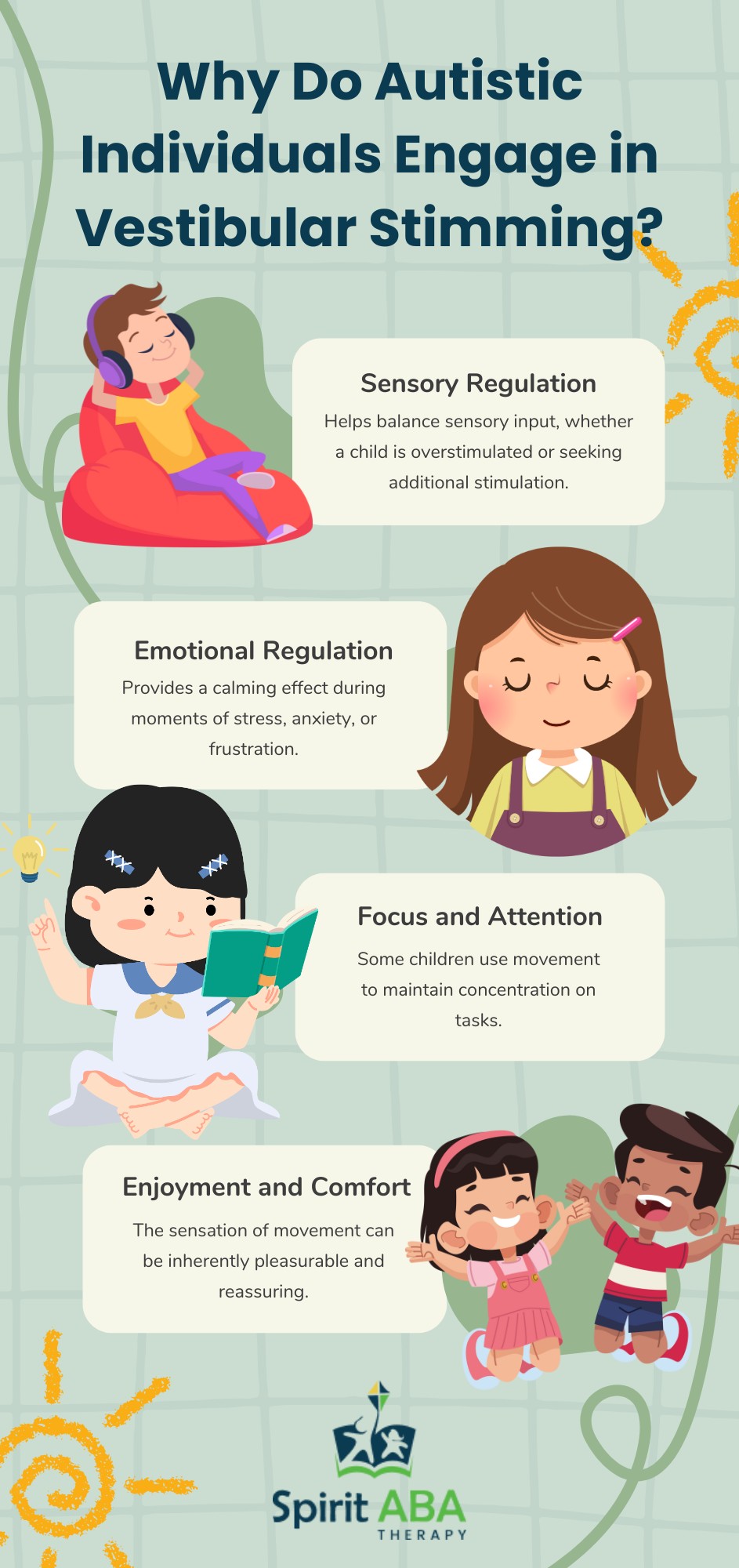Key Points:
- Vestibular stimming involves repetitive movements like spinning or rocking to regulate sensory input.
- It plays a crucial role in self-soothing, sensory processing, and emotional regulation for individuals with autism.
- Recognizing and understanding vestibular stimming helps parents and caregivers support autistic children effectively.
Have you ever noticed your child spinning, rocking, or jumping repeatedly? These movements, known as vestibular stimming, help autistic individuals regulate sensory input. While they may seem unusual, they serve an important purpose. Understanding why your child engages in them can help you support their sensory needs in meaningful ways.
What Is Vestibular Stimming?
Vestibular stimming refers to repetitive movements that stimulate the vestibular system, which controls balance and spatial awareness. This includes actions such as spinning, rocking, swinging, or head shaking. Many autistic individuals engage in vestibular stimming as a way to regulate their sensory experiences.
For some, these movements provide a sense of comfort and control, while for others, they help manage overstimulation or sensory-seeking behaviors. Recognizing that vestibular stimming is a self-regulation tool rather than just a habit allows parents to better support their child’s needs.
Why Do Autistic Individuals Engage in Vestibular Stimming?
Vestibular stimming is deeply connected to how the brain processes movement and sensory input. While everyone engages in some form of self-stimulation (like tapping a foot or swaying), autistic individuals often rely on more noticeable vestibular movements for regulation.

Common Types of Vestibular Stimming
Vestibular stimming can take many different forms, depending on a child’s sensory needs. Some children seek intense movement, while others prefer more subtle rocking or swaying. Recognizing these behaviors can help parents and caregivers create safe and structured opportunities for movement.
1. Spinning and Twirling
Many autistic children enjoy spinning in circles, either by themselves or on playground equipment like merry-go-rounds. They may also twirl objects in their hands, such as toys, ribbons, or even household items. Spinning provides strong vestibular input and can be calming or stimulating, depending on the child’s sensory profile.
2. Rocking Back and Forth
Rocking is one of the most common forms of vestibular stimming. Some children rock while sitting, standing, or lying down. They may also seek out rocking chairs or swings for rhythmic movement. Rocking can be soothing, especially in stressful or overstimulating situations.
3. Jumping and Bouncing
Some children engage in constant jumping—on beds, couches, trampolines, or even while standing in place. Bouncing on exercise balls or repeatedly leaping off furniture can also provide vestibular input. These activities help regulate energy levels and enhance body awareness.
4. Head Movements
Head shaking, nodding, or tilting side to side are common vestibular stimming behaviors. Some children enjoy hanging their heads upside down to increase sensory input. These repetitive head movements help with balance and orientation, though excessive movement should be monitored for safety.
5. Swinging and Hanging Upside Down
Swinging is a favorite activity for many autistic children because it provides continuous vestibular input. Some children may also hang upside down from playground equipment or furniture, as inversion can offer a unique sensory experience. Controlled swinging can be an excellent way to support sensory regulation.
When Should Parents Be Concerned About Vestibular Stimming?
In most cases, vestibular stimming is a normal and beneficial self-regulation tool. However, there are situations where intervention may be necessary.
- Excessive or Unsafe Movements – If a child spins to the point of dizziness or loses balance frequently, they may be at risk of injury.
- Disruption of Daily Activities – If stimming prevents participation in learning, social interactions, or daily routines, adjustments may be needed.
- Increased Intensity During Stressful Situations – If vestibular stimming escalates during distress, a child may need alternative coping mechanisms.
- Self-Injurious Behavior – If stimming includes head-banging or aggressive movements that cause harm, professional guidance is recommended.
How Can Parents Support Healthy Vestibular Stimming?
Rather than discouraging vestibular stimming, parents can incorporate structured movement activities that help meet a child’s sensory needs in a safe way.
- Provide Safe Movement Options: Offer trampolines, swings, or therapy balls to channel vestibular input safely.
- Create Scheduled Sensory Breaks: Allow structured time for movement during daily routines.
- Use Deep Pressure Activities: Pair movement with activities like weighted blankets or compression clothing to enhance sensory regulation.
- Encourage Physical Play: Activities like swimming, biking, or yoga can fulfill vestibular needs in a controlled manner.
- Communicate with Therapists: Work with ABA professionals or occupational therapists to integrate beneficial movement strategies into daily life.

The Role of ABA Therapy in Supporting Sensory Needs
ABA therapy helps autistic children develop self-regulation strategies while ensuring their sensory needs are met. For children who engage in vestibular stimming, ABA professionals can create structured plans to balance sensory input and daily activities. Instead of discouraging movement, ABA therapy helps children learn when, where, and how to stim safely and effectively.
Therapists first assess a child’s sensory preferences—whether they are sensory-seeking or sensory-avoidant. This helps in designing individualized interventions that support both sensory regulation and functional skills. By understanding the reasons behind vestibular stimming, ABA therapy ensures that movement-based behaviors are integrated into daily routines in a constructive way.
ABA techniques also focus on alternative coping strategies when stimming interferes with learning or social interactions. Therapists might introduce sensory breaks, structured movement activities, or deep-pressure techniques as alternative ways to self-regulate. Instead of eliminating vestibular stimming, ABA therapy guides children in using it appropriately while fostering communication, independence, and emotional regulation.
Find Expert ABA Support at Spirit ABA
If your child engages in vestibular stimming and you’re seeking professional guidance, Spirit ABA provides expert ABA therapy tailored to individual sensory and behavioral needs.
Our team helps children develop self-regulation skills while ensuring their sensory needs are met in a safe and structured environment. We proudly provide ABA therapy services in Iowa, Colorado, and Nebraska, and are dedicated to supporting children with autism through evidence-based interventions.
Contact Spirit ABA today to learn how we can help your child thrive in a sensory-friendly environment!

